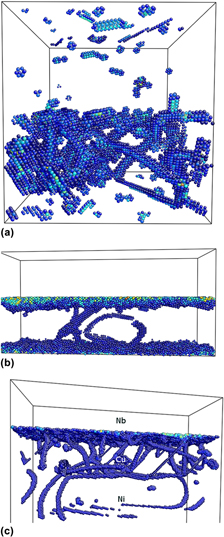Crossref Citations
This article has been cited by the following publications. This list is generated based on data provided by
Crossref.
Zbib, Hussein M.
Overman, Cory T.
Akasheh, Firas
and
Bahr, David
2011.
Analysis of plastic deformation in nanoscale metallic multilayers with coherent and incoherent interfaces.
International Journal of Plasticity,
Vol. 27,
Issue. 10,
p.
1618.
Shao, S.
Zbib, H. M.
Mastorakos, I. N.
and
Bahr, D. F.
2012.
Deformation mechanisms, size effects, and strain hardening in nanoscale metallic multilayers under nanoindentation.
Journal of Applied Physics,
Vol. 112,
Issue. 4,
Zbib, Hussein M.
2012.
Generalized Continua and Dislocation Theory.
p.
289.
Abdolrahim, N.
Mastorakos, I.N.
and
Zbib, H.M.
2012.
Precipitate strengthening in nanostructured metallic material composites.
Philosophical Magazine Letters,
Vol. 92,
Issue. 11,
p.
597.
Shao, S.
Zbib, H. M.
Mastorakos, I.
and
Bahr, D. F.
2013.
Effect of Interfaces in the Work Hardening of Nanoscale Multilayer Metallic Composites During Nanoindentation: A Molecular Dynamics Investigation.
Journal of Engineering Materials and Technology,
Vol. 135,
Issue. 2,
Coll, M
Guzman, R
Garcés, P
Gazquez, J
Rouco, V
Palau, A
Ye, S
Magen, C
Suo, H
Castro, H
Puig, T
and
Obradors, X
2014.
Size-controlled spontaneously segregated Ba2YTaO6nanoparticles in YBa2Cu3O7nanocomposites obtained by chemical solution deposition.
Superconductor Science and Technology,
Vol. 27,
Issue. 4,
p.
044008.
Abdolrahim, N.
Mastorakos, I.N.
Shao, S.
Bahr, D.F.
and
Zbib, H.M.
2014.
The effect of interfacial imperfections on plastic deformation in nanoscale metallic multilayer composites.
Computational Materials Science,
Vol. 86,
Issue. ,
p.
118.
Abdolrahim, Niaz
Zbib, Hussein M.
and
Bahr, David F.
2014.
Multiscale modeling and simulation of deformation in nanoscale metallic multilayer systems.
International Journal of Plasticity,
Vol. 52,
Issue. ,
p.
33.
Anderson, Peter M.
Carpenter, John S.
Gram, Michael D.
and
Li, Lin
2014.
Handbook of Nanomaterials Properties.
p.
495.
Zhou, Xiaoling
and
Chen, Changqing
2015.
Molecular dynamic simulations of the mechanical properties of crystalline/crystalline and crystalline/amorphous nanolayered pillars.
Computational Materials Science,
Vol. 101,
Issue. ,
p.
194.
Polyakov, Mikhail N.
Lohmiller, Jochen
Gruber, Patric A.
and
Hodge, Andrea M.
2015.
Load Sharing Phenomena in Nanoscale Cu/Nb Multilayers.
Advanced Engineering Materials,
Vol. 17,
Issue. 6,
p.
810.
Schoeppner, R.L.
Wheeler, J.M.
Zechner, J.
Michler, J.
Zbib, H.M.
and
Bahr, D.F.
2015.
Coherent Interfaces Increase Strain-Hardening Behavior in Tri-Component Nano-Scale Metallic Multilayer Thin Films.
Materials Research Letters,
Vol. 3,
Issue. 2,
p.
114.
Huang, Sixie
Beyerlein, Irene J.
and
Zhou, Caizhi
2017.
Nanograin size effects on the strength of biphase nanolayered composites.
Scientific Reports,
Vol. 7,
Issue. 1,
Yang, Wei
Ayoub, Georges
Salehinia, Iman
Mansoor, Bilal
and
Zbib, Hussein
2017.
Deformation mechanisms in Ti/TiN multilayer under compressive loading.
Acta Materialia,
Vol. 122,
Issue. ,
p.
99.
Fleming, Robert A.
and
Zou, Min
2017.
The effects of confined core volume on the mechanical behavior of Al/a-Si core-shell nanostructures.
Acta Materialia,
Vol. 128,
Issue. ,
p.
149.
Mastorakos, Ioannis N.
Schoeppner, Rachel L.
Kowalczyk, Brian
and
Bahr, David F.
2017.
The effect of size and composition on the strength and hardening of Cu–Ni/Nb nanoscale metallic composites.
Journal of Materials Research,
Vol. 32,
Issue. 13,
p.
2542.
Damadam, Mohsen
Shao, Shuai
Salehinia, Iman
Ayoub, Georges
and
Zbib, Hussein M.
2017.
Molecular dynamics simulations of mechanical behavior in nanoscale ceramic–metallic multilayer composites.
Materials Research Letters,
Vol. 5,
Issue. 5,
p.
306.
Huang, C.X.
Wang, Y.F.
Ma, X.L.
Yin, S.
Höppel, H.W.
Göken, M.
Wu, X.L.
Gao, H.J.
and
Zhu, Y.T.
2018.
Interface affected zone for optimal strength and ductility in heterogeneous laminate.
Materials Today,
Vol. 21,
Issue. 7,
p.
713.
Gola, Adrien
Gumbsch, Peter
and
Pastewka, Lars
2018.
Atomic-scale simulation of structure and mechanical properties of Cu1−xAgx|Ni multilayer systems.
Acta Materialia,
Vol. 150,
Issue. ,
p.
236.
Schoeppner, R.L.
Taylor, A.A.
Cordill, M.J.
Zbib, H.M.
Michler, J.
and
Bahr, D.F.
2018.
Precipitate strengthening and thermal stability in three component metallic nanolaminate thin films.
Materials Science and Engineering: A,
Vol. 712,
Issue. ,
p.
485.



